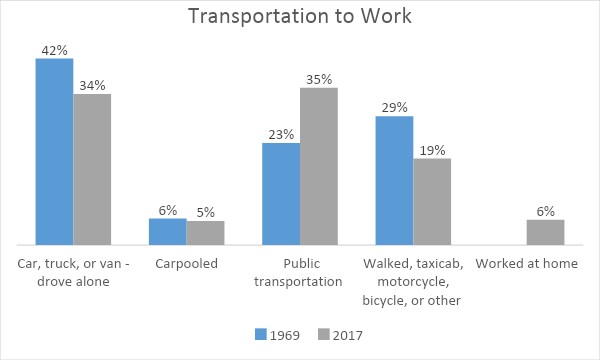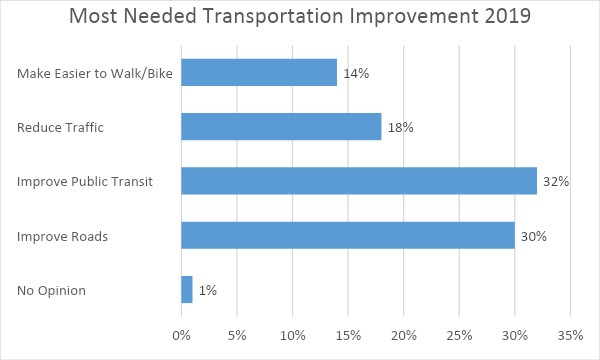Freeway widening was a bad idea in 1969, and it’s a bad idea now
_800_450_90.jpg)
I-495 (Capital Beltway) in Tysons Corner, Virginia by Daniel Kelly used with permission.
The more things change, the more they stay the same. A survey conducted in 1969 shows that the ongoing debate over highway expansion in the Washington region today has an uncanny resemblance to the region’s historical debate over building roads or rails. Despite dramatic changes in technology, data, and the demographics of the region, many policymakers have yet to learn that expanding freeways is not an effective way to reduce travel times.
In the years leading up to the construction of the Metro, now the third-busiest rapid transit system in the country, the Washington region was caught in a fierce debate between building a rapid rail transit system and expanding the interstate highway system. Citizens, government officials, and businesses agreed that major improvements to the transportation system were necessary to allow the region to grow. The challenge was agreeing on the right transportation for the future of the region.
Throughout the 1960s multiple plans were created that would have built freeways around the heart of DC. The idea was to build a system that would allow people to quickly commute from their homes in the suburbs to their work in the city center.
Planners designed massive projects such as the Three Sisters Bridge, a freeway through or under the National Arboretum, and an interstate interchange on 14th and U streets, which would have wiped out the corridor of Black businesses there, deemed at the time as “obsolete.” Urban planners were so eager to address transportation concerns by building freeways through the city that they even went as far as designing a six-lane highway under the Lincoln Memorial.
Environmental Action on August 7, 1971; Emergency Committee on the Transportation Crisis (ECTC). Image from series 07B, Box 10, Folder no. 18, University of Baltimore Special Collections and Archives. Image used with permission.
Thankfully, coalitions and citizen groups were able to stop most of the freeway plans, except for the Southeast Freeway and the Anacostia Freeway. In total, 36.4 miles of freeways were planned in the District but only 10.7 miles were built. By preventing the construction of the freeways, advocates were able to save neighborhoods and reallocate more than $1 billion originally budgeted for highway construction to building the Metro.
In 1969, the Federal City Council commissioned a report to study the attitude of DC residents on the proposals for freeway construction in the District. The report, titled A Survey of Public Opinion in Washington, DC Regarding New Freeways, showed that the main priority of District residents then was getting to work faster. It is no different today.
Survey of Public Opinion in Washington, DC Regarding New Freeways.Oliver Quayle and Company, 1969. 
In 1969, the most frequent reason people gave for supporting freeway expansion was if it would provide faster transportation. However, when given the choice between constructing roads and constructing the Metro, residents said that the region should prioritize constructing the Metro. In fact, 52% of respondents said the top priority should be constructing the Metro while only 25% said more freeways were most needed.
US Census Bureau; American Community Survey, 2017 American Community Survey 5-Year Estimates and Survey of Public Opinion in Washington, DC Regarding New Freeways. Oliver Quayle and Company, 1969. 
DC Residents; Washington Post-Schar School telephone poll April 25-May 2, 2019. The Washington Post and George Mason University’s Schar School of Policy and Government, 2019. 
Similar to the 60s, much of the debate today has centered around commute times but residents have continued to show strong support for prioritizing investments in the Metro, with 70% saying they would support an increase in public funding for the Metro.
Edelman Intelligence for FC2/BOT/2030/The Partnership. 
According to Walter Fauntroy, chairman of the WMATA board in 1969, DC residents knew in the 60s, “As soon as you build [freeways], they’re full.” Data has since shown this “fundamental rule” of freeway congestion by showing that increasing the size of freeways does not reduce congestion; instead, more people end up using the road. Economists call this phenomenon induced demand.
When researchers analyzed data nationwide from 1983-2003, they found a one-to-one relationship between miles of interstate and the amount people drive. The lived experience of commuters in many metropolitan areas support these findings. In 2014, LA completed a $1.6 billion project to widen I-405 over a 10-mile stretch. In the years since, commuters have seen travel times stay the same or increase at every time of the day.
While DC has remained consistent its opposition to widening roads, policymakers in Virginia and Maryland have yet to learn that it is impossible to widen a freeway out of congestion. Virginia is currently working on several lane widening projects, including on I-66 and on I-395. Maryland Governor Larry Hogan is also pushing for an $11 billion plan to widen the Capital Beltway (I-495) and I-270 as a part of his “Traffic Relief Plan.”
Both projects are being publicized as efforts to reduce congestion and speed up commute times. However, according to the recent Washington Post-Schar School telephone poll, over 75% of Montgomery and Prince George’s counties residents are concerned that the expansion will require the destruction of homes, be too expensive to use, and fail to reduce congestion.
In 1969, DC residents recognized that the solution to the region’s transportation needs was more investment in public transportation, not building freeways. Today, cities around the country are paying millions of dollars to remove their freeways and revitalize their communities. We should learn from the past and be intentional in our transportation solutions and policymaking now. We couldn’t widen our way out of congestion in 1969, and we can’t do it today.
